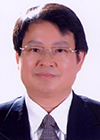

Small Molecular Machines on Solid Surfaces and the Manipulation of Fundamental Physical Properties at the Atomic Scale
Abstract:Construction of functional structure at nanometer scale plays an important role in the development of science and technology. One of the most important functional structures at nanoscale is molecular machines made from functional molecules. Hongjun Gao and his collaborators has studied systematically on the construction and physical properties of quantum nanostructures with the help of scanning tunneling microscopy/spectroscopy (STM/STS). They constructed molecular rotors with a ?xed off-center rotation axis using single tetra-tert-butyl zinc phthalocyanine molecules on an Au(111) surface the first time. Furthermore, these single molecular rotors self-assemble into large scale ordered arrays on Au(111) surfaces. A ?xed rotation axis off center is an important step towards the eventual fabrication of molecular motors or generators. They proposed for the first time that the Fano resonance depends strongly on the adsorption site of the molecule on a gold surface. They demonstrate that the Kondo resonance of manganese phthalocyanine molecules on a Au(111) substrate have been reversibly switched off and on via a robust route through attachment and detachment of single hydrogen atom to the magnetic core of the molecule. A storage system based on the molecular spin states thus describes the ultimate limit of information storage (280 T/inch2). Furthermore, by using a series of dehydrogenated Mn-phthalocyanine molecule on Au(111) as a platform, they demonstrated for the first time that the site-dependent g factor of a single magnetic molecule with intramolecular resolution. These results open up a new route to access local spin properties within a single molecule.
Awardee:Dr. Hong-jun Gao was born in 1963. He obtained his Ph.D. from Peking University in 1994. He is now a Professor and Group Leader in Institute of Physics, Chinese Academy of Sciences, Academician of the Chinese Academy of Sciences, and Academician of the Developing-country Academy of Sciences (TWAS). He is now serving as an Associate Editor for Appl. Phys. Lett. and editorial board members for several international journals. He was the Vice President of the University of Chinese Academy of Sciences (U-CAS) and Chair of the U-CAS Advisory Committee of Sciences. He was the Scientific Secretary of the International Union of Vacuum Science, Technology, and Applications (IUVSTA) in the triennium 2004-2007, and the Chairman of the NSTD, IUVSTA (2010-2013). From 1997 to 2000, he worked at the Oak Ridge National Laboratory (ORNL) as a Guest Scientist.
His research interests are in construction and physical properties of quantum nanostructures and scanning tunneling microscopy/spectroscopy (STM/STS). He has 6 international books/chapters, more than 350 journal publications including Physical Review Letter, Journal of American Chemical Society, Advanced Materials and Nature series, and more than 90 invited talks. His research on the construction of an "anchored" single molecular rotor array, and on nanorecording using conductance transition at a single molecular scale, have been highlighted by the American Physical Society–physics, Physical Review Focus, Science News, Nature Materials, and Nature Nanotechnology.
In 2008 and 2009, he was awarded the "OCPA AAA (Robert Prize)" (OCPA: the Overseas Chinese Physics Association; AAA: Achievement in Asia Award), the "TWAS Prize in Physics 2009" (TWAS: Third World Academy of Sciences), "Humboldt Research Award 2010", "2012 Science and Technology Awards of the Ho Leung Ho Lee", and "2013’s Outstanding Science and Technology Achievement Prize of the Chinese Academy of Sciences".